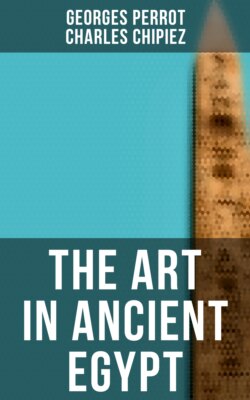Читать книгу The Art in Ancient Egypt - Perrot Georges - Страница 8
На сайте Литреса книга снята с продажи.
III.
ОглавлениеTable of Contents
Thanks to the numerous discoveries of the last fifty years, and to the comparisons which they have suggested, thanks also to the theories for which they afford a basis, history has been at last enabled to render justice to certain nations whose activity had never before been properly understood, to give to them their proper place in the civilization of ancient times. But Greece—the Greece which Ottfried Müller worshipped, and for which he was too ready to sacrifice her predecessors and teachers, to whom she herself was more just in her early legends—has lost nothing by the more exact information which is now at our command. Served by her situation on the confines of Europe and Asia and not far from Africa, by the superiority of the genius of her people and the marvellous aptitudes of her language, Greece was able to arrange and classify previous discoveries and to bring them to perfection, to protect from destruction and oblivion the machinery of progress, the processes of art, the newly-born scientific methods, in a word, all the complex and fragile apparatus of civilization which was so often threatened with final destruction, and which has more than once been overwhelmed for a time in epochs of national conflict and social decadence.
This is not the place for insistence upon all that Greece has accomplished in the domains of pure thought, philosophy, and science, nor even for calling attention to her literature. We are writing the history of the arts and not that of letters, a history which we wish to conduct to the point where Müller left off, to the commencement of those centuries which are called the Middle Ages; and Greece will occupy by far the most important place in our work. We shall endeavour to bring the same care and conscience, the same striving after accuracy, into every division of our history; but the monuments of Greece will be examined and described in much greater detail than those of Egypt and Assyria, or even those of Etruria and Latium. It was our love for Greece that drove us to this undertaking; we desire and hope to make her life better known, to show a side of it which is not to be found in the works of her great writers, to give to our readers new and better reasons for loving and admiring her than they have had before. A combination of circumstances that is unique in the history of the world gave to the contemporaries of Pericles and Alexander the power of approaching more nearly to perfection, in their works of art, than men of any other race or any other epoch. In no other place or time have ideas been so clearly and completely interpreted by form; in no other place or time have the intellectual qualities been so closely wedded to a strong love for beauty and a keen sensibility to it. It results from this that the works of the Greek artists, mutilated by time and accident as they are, serve as models and teachers for our painters and sculptors, a rôle which they will continue to fill until the end of time. They form a school, not, as some have thought, to enable us to dispense with nature, the indispensable and eternal master, but to incite to such an ardent and intelligent study of her beauties, as may lead to the creation of great works, works capable, like those of the Greeks, of giving visible expression to the highest thoughts.
As the Greeks excelled all other nations in the width and depth of their æsthetic sentiments; as their architects, their sculptors, and their painters, were superior both to their pupils and their masters, to the orientals on the one hand, and the Etruscans and the Latins on the other, we need feel no surprise at their central and dominating position in the history of antique art. Other national styles and artistic manifestations will pass before the eye of the reader in their due order and succession; they will all be found interesting, because they show to us the continual struggle of man against matter, and we shall endeavour to distinguish each by its peculiar and essential characteristics, and to illustrate it by the most striking remains which it has left behind. But each style and nationality will for us have an importance in proportion to the closeness of its connection with the art of Greece. In the case of those oriental races which were the teachers of the Greeks, we shall ask how much they contributed to the foundations of Greek art and to its ultimate perfection; in the case of the ancient Italians, we shall endeavour to estimate and describe the ability shown by them in apprehending the lessons of their instructors, and the skill with which they drew from their teachers a method for the expression of their own peculiar wants and feelings and for the satisfaction of their own æsthetic desires.
The study of oriental art will really, therefore, be merely an introduction to our history as a whole, but an introduction which is absolutely required by our plan of treatment, and which will be completely embodied in the work. The history of Etruscan and Roman art will be its natural and necessary epilogue.
